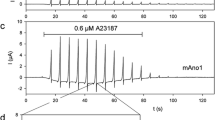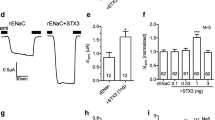Abstract.
In the present experiments we exposed the intra- or extracellular surface of excised giant membrane patches of Xenopus laevis oocytes bathed in 140 mmol/l Na-aspartate solution to the anion transport inhibitor 4,4′-diisothiocyanatostilbene-2,2′-disulfonate (DIDS, 250 µmol/l). We observed that DIDS activated at least two cation conductances: (1) a non-selective cation (NSC) conductance that was mediated by channels of approximately 27 pS and resembled the stretch-activated cation conductance that has been observed in the oocyte cell membrane previously, and (2) a Na+-selective conductance, the single-channel events of which could not be resolved and which resembled the depolarization-induced Na+ conductance that has also been observed in the oocyte cell membrane previously. Both conductances were blocked by 1 mmol/l amiloride from the intra- and extracellular surfaces but inhibition of the NSC conductance by extracellular amiloride was less pronounced. Both conductances activated only slowly with a delay of 15–60 s after application of DIDS and remained active even after DIDS was washed off. This suggests that DIDS caused the exocytosis of preformed channels and this interpretation was supported by our additional observation that extracellular application of maitotoxin (MTX) mimicked the effects of DIDS. MTX is a marine toxin that has recently been reported to induce exocytosis in Xenopus laevis oocytes. The fact that DIDS and MTX each carry two sulfonyl groups suggests that they act on the same positively charged binding sites of an exocytosis-inducing protein. Our observations demonstrate that using DIDS to inhibit heterologously expressed anion transporters in the cell membrane of Xenopus laevis oocytes may compromise proper determination of the transporter currents. This effect can be prevented if the DIDS-activated endogenous cation conductances are suppressed by application of amiloride to the cytoplasmic surface of the cell membrane.
Similar content being viewed by others
Author information
Authors and Affiliations
Additional information
Electronic Publication
Rights and permissions
About this article
Cite this article
Diakov, A., Koch, JP., Ducoudret, O. et al. The disulfonic stilbene DIDS and the marine poison maitotoxin activate the same two types of endogenous cation conductance in the cell membrane of Xenopus laevis oocytes. Pflügers Arch - Eur J Physiol 442, 700–708 (2001). https://doi.org/10.1007/s004240100593
Received:
Revised:
Accepted:
Issue Date:
DOI: https://doi.org/10.1007/s004240100593




